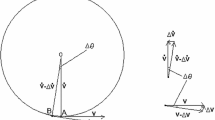Abstract.
When an object is bound at rest to an attractional field, its rest mass (owing to the law of energy conservation, including the mass and energy equivalence of the Special Theory of Relativity) must decrease. The mass deficiency coming into play indicates a corresponding rest energy discharge. Thus, bringing an object to a rotational motion means that the energy transferred for this purpose serves to extract just as much rest mass (or similarly “rest energy”, were the speed of light in empty space taken to be unity) out of it. Here, it is shown that during angular acceleration, photons of fundamental energy \( h\varpi/2\pi\) are emitted, while the object is kept on being delivered to a more and more intense rotational accelerational field, \( \varpi\) being the instantaneous angular velocity of the rotating object. This fundamental energy, as seen, does not depend on anything else (such as the mass or charge of the object), and it is in harmony with Bohr’s Principle of Correspondence. This means at the same time, that emission will be achieved, as long as the angular velocity keeps on increasing, and will cease right after the object reaches a stationary rotational motion (a constant centrifugal acceleration), but if the object were brought to rotation in vacuum with no friction. By the same token, one can affirm that even the rotation at a macroscopic level is quantized, and can only take on “given angular velocities” (which can only be increased, bit by bit). The rate of emission of photons of concern is, on the other hand, proportional to the angular acceleration of the object, similarly to the derivative of the tangential acceleration with respect to time. It is thus constant for a “constant angular acceleration”, although the energy \( h\varpi/2\pi\) of the emitted photons will increase with increasing \( \varpi\) , until the rotation reaches a stationary level, after which we expect no emission --let us stress-- if the object is in rotation in vacuum, along with no whatsoever friction (such as the case of a rotating diatomic molecule, for instance). If the object reaches its final state in a given medium, say air, and “friction” is present, such as the case of a dental drill, then energy should keep being supplied to it, to overcome friction, which is present either inside the “inner mechanism of rotation” or in its surroundings. In other words, the object in the latter case, would be constantly subject to a friction force, countering its motion, and tending to make it fall to lower rotational energy states. Any fluctuations in the power supply, on the other hand, will slow down the rotating object, no matter how indiscernibly. The small decrease in the rotational velocity is yet reincreased by restoring the power supply, thus perpetually securing a stationary rotational motion. Thereby, the object in this final state, due to fluctuations in either friction or power supply, or both, shall further be expected to emit a radiation of energy \( h\varpi_{f}/2\pi\) , where \( \varpi_{f}\) is the final angular velocity of the object in rotation. What is more is that our team has very successfully measured what is predicted here, and they will report their experimental results in a subsequent article. The approach presented here seems to shed light on the mysterious sonoluminescence. It also triggers the possibility of sensing earthquakes due to radiation that should be emitted by the faults, on which the seismic stress keeps increasing until the crackdown. By the same token, also two colliding (neutral) objects are expected to emit radiation.
Similar content being viewed by others
References
T. Yarman, Found. Phys. Lett. 19, 675 (2006)
I. Newton, Principia, Book III (1686)
T. Yarman, Superluminal Interaction Making the Basis of Quantum Mechanics (Academic Publication, Lambert, 2011)
T. Yarman, M. Arik, A.L. Kholmetskii, A Critical Analysis of Einstein's Non-Conform Analogy Between Rotation and Gravitatiton - Part II: Harmony Between Non-Locality and STR in Both Micro and Macro Worlds, in Mathematics, Physics and Philosophy in the Interpretations of Relativity Theory II, 4--6 September 2009, Budapest available at http://www.phil-inst.hu/~szekely/pirt_bp_2/papers/papers.htm
A.L. Kholmetskii, O.V. Missevitch, R. Smirnov-Rueda, R. Ivanov, A.E. Chubykalo, J. Appl. Phys. 101, 023532 (2007)
D. Salart, A. Baas, C. Branciard, N. Gisin, H. Zbinden, Nature 454, 861 (2008)
Was Einstein Wrong? A Quantum Threat to Special Relativity (Scientific American, 2009)
P.A.M. Dirac, Proc. R. Soc. A: Math. Phys. Eng. Sci. 117, 610 (1928) DOI:10.1098/rspa.1928.0023
P.A.M. Dirac, Proc. R. Soc. A: Math. Phys. Eng. Sci. 126, 360 (1930) DOI:10.1098/rspa.1930.0013
A. Einstein, B. Podolsky, N. Rosen, Phys. Rev. 47, 777 (1935)
R. Anderson, H.R. Bilger, G.E. Stedman, Am. J. Phys. 62, 975 (1994) DOI:10.1119/1.17656
Paul Ehrenfest, Phys. Z. 10, 918 (1909)
T. Yarman, V.B. Rozanov, M. Arik, in Proceedings of the International Meeting on Physical Interpretation of Relativity Theory (Moscow, 2--5 July 2007), edited by M.C. Duffy (BMSTU PH, Moscow)
A.L. Kholmetskii, T. Yarman, O.V. Missevitch, Phys. Scr. 77, 035302 (2008)
A.L. Kholmetskii et al., Phys. Scr. 79, 065007 (2009)
A.L. Kholmetskii, T. Yarman, O.V. Missevitch, Nuovo Cimento B 124, 791 (2009)
A.L. Kholmetskii, T. Yarman, O.V. Missevitch, Eur. Phys. J. Plus 128, 42 (2013)
T. Yarman, Phys. Essays 26, 473 (2013)
J. Larmor, Philos. Trans. R. Soc. 190, 205 (1897)
Author information
Authors and Affiliations
Corresponding author
Rights and permissions
About this article
Cite this article
Yarman, T., Arik, M. & Kholmetskii, A.L. Radiation from an accelerating neutral body: The case of rotation. Eur. Phys. J. Plus 128, 134 (2013). https://doi.org/10.1140/epjp/i2013-13134-9
Received:
Revised:
Accepted:
Published:
DOI: https://doi.org/10.1140/epjp/i2013-13134-9



